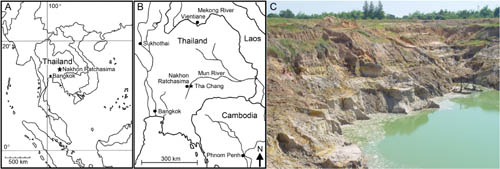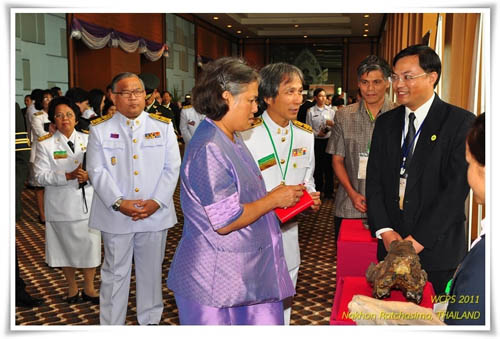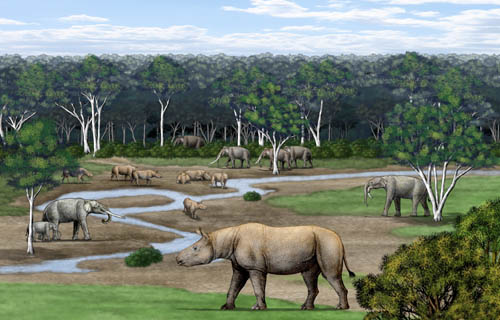| Location: Home > Research > Research Progress |
| A New Species of the Hornless Rhino Found From the Late Miocene of Nakhon Ratchasima, Thailand |
|
In the Tha Chang area, Nakhon Ratchasima Province, Thailand, several sand pits previously have yielded fossils. The area is 220 km northeast of Bangkok, and the sand pits are located next to the Mun River. The sedimentary sequence of these sand pits consists of unconsolidated mudstone, sandstone, and conglomerate, deposited by the ancient Mun River. Almost all the fossils have been found and collected by local villagers working in these sand pits, and they have been brought to public institutions such as Nakhon Ratchasima Rajabhat University. Consequently, precise field information is unavailable for most of the fossils from the Tha Chang area, including the type mandible of the recently described new hominoid Khoratpithecus piriyai.
Dr. DENG Tao from Institute of Vertebrate Paleontology and Paleoanthropology (IVPP), Chinese Academy of Sciences, and his Thai colleagues from Nakhon Ratchasima Rajabhat University studied the rhino fossils collected from the Tha Chang sand pits and described them as a new species of the subfamily Aceratheriinae, Aceratherium piriyai sp. nov. Its holotype is an adult skull without premaxillae and the anterior portion of nasals, and its paratype is an almost complete mandible. Her Royal Highness Princess Sirindhorn of Thailand was interested in this study and watched the holotype of A. pirayai when Dr. Deng and his Thai colleagues studied these fossils in Nakhon Ratchasima. The study is published online June 26, 2013 in Journal of Vertebrate Paleontology.
Cuvier (1822) created the species Rhinoceros incisivus based on an isolated first upper incisor of large size from the Middle Miocene locality of Weisenau in Germany, but the tooth unambiguously belongs to a genus of the tribe Teleoceratini. Kaup (1832) described two skulls of a hornless rhinoceros from the Late Miocene locality of Eppelsheim in Germany, and he created a new genus Aceratherium for them, but used Cuvier’s species. The prevailing usage of Aceratherium incisivum Kaup, 1832 is conserved in fact. Since Kaup (1832), many rhinoceroses, at least 83 species, have been described as species of Aceratherium, relegating this genus to a wastebasket taxon. Later, however, most of the species were referred to other genera within the subfamily Aceratheriinae or to other rhino groups.
A. piriyai has several characters that are more derived than in A. incisivum and A. depereti, such as very broadly separated parietal crests, a straight nuchal crest, and longer metalophs on M1-2. But A. piriyai also has some more primitive characters than A. incisivum, such as narrow zygomatic arches, a progressive anterior tip of the maxillary zygomatic process, and absence of the medifossette on P4.
The very broadly separated parietal crests, an important derived character in the morphological evolution of aceratheres, indicate that the age of A. piriyai must be later than the ages of the time-successive Aceratherium depereti-A. incisivum. A. depereti came from the Lower Miocene deposits of the Turgai region in Kazakhstan, and A. incisivum was distributed in MN 9-10 of the early Late Miocene of Western Europe. As a result, the age of A. piriyai should be the late Late Miocene. The stegolophodonts from the Tha Chang sand pits are more primitive than Stegodon in northern China, suggesting that the Tha Chang sand pits are older than 6 Ma. Based on other mammalian fossils from the Tha Chang area, the age of the fossiliferous deposits in Tha Chang Sand Pit 8 has been estimated to be 9-7 Ma, and later, 7.4-5.9 Ma. A. piriyai indicates that the age of 7.4-5.9 Ma should be reasonable for the Tha Chang sand pits.
On the other hand, while A. piriyai has a mixture of derived and primitive character states compared to A. incisivum, it is not more primitive than A. depereti. As a result, A. depereti could be the ancestor of both A. incisivum and A. piriyai. A. depereti was distributed in Central Asia, so its descendents, A. incisivum and A. piriyai would have dispersed westward to Europe and southward to South Asia, respectively, evolving different derived characters in different evolutionary trends from A. depereti.
The occipital surface of A. depereti is vertical or apparently feebly deflected backward, which is a primitive character compared to the posteriorly inclined occiput of A. incisivum. The occipital surface of the Tha Chang rhino is slightly inclined posteriorly or nearly vertical, and the cheek teeth are subhypsodont, both indicating a woodland habitat. This result is identical with the paleobotanical evidence for the Tha Chang sand pits, which indicates the occurrence of wet and tropical forest environments.
This work was supported by the National Basic Research Program of China, the Strategic Priority Research Program of the Chinese Academy of Sciences, and the National Natural Science Foundation of China.  Fig.1 Location and section of Tha Chang in Nakhon Ratchasima Province, northeastern Thailand  Fig.2 Holotype skull of Aceratherium piriyai sp. nov.  Fig.3 Princess Sirindhorn was listening to the introduction of Dr. Deng about the holotype skull  Fig.4 Reconstruction of the Late Miocene habitat of Aceratherium piriyai at Tha Chang (illustrated by Chen Yu) |